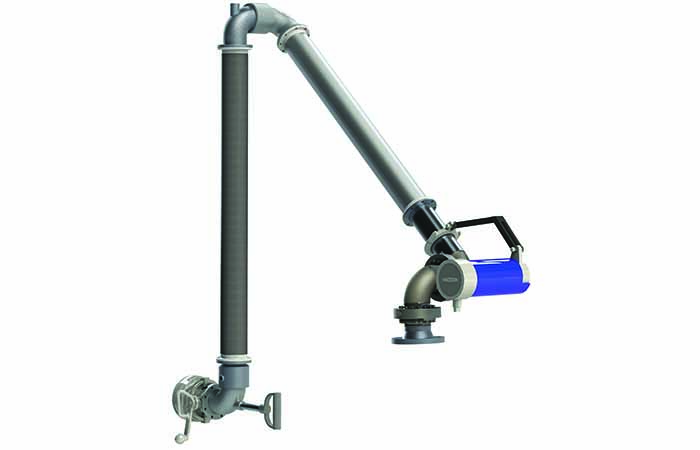
One of Dixon’s newest product developments is our loading arm which can be configured and built to a customer’s specification. Dixon’s loading arms are engineered for long life performance as well as ease of use in the field and can be used to overcome some of the typical issues and complications faced in the transfer of liquids.
Loading arms are becoming the standard choice over hoses for certain applications in refineries, chemical plants, food & beverage processing plants, rail terminals and truck terminals. There are many variables involved in making the decision to purchase a loading arm. They can be based on application, material, location, site limitations, etc. Safety should always be considered first when protecting your most important asset, your employees. Is a loading arm actually a safer option than a standard hose assembly? It is important to review key factors and examine the impact on safety when looking to make a choice between the two.
Weight & the benefits of a counter balance
What is the media that is being transferred? Is the weight of the hose an issue? A 4 inch hose assembly filled with liquid could potentially weigh 6kg per metre. In this situation you could be asking your employees to drag a 100kg, 6 metre hose assembly. This could contribute to a high potential for back injuries and worker compensation injury claims. Even if the hose was shorter it would still add a significant amount of strain and stress on the worker. Switching this application to a loading arm would reduce the chance of an injury tremendously. The counterbalance mechanism of a loading arm is designed to balance the weight and do the heavy lifting for you and, combined with a handle, it becomes a very ergonomic solution.
The design of the Dixon loading arm incorporates an additional safety factor by having a steel housing for the Counterbalance torsion spring rather than the conventional plastic housing for better durability and long life performance. The unique counterbalance adjustment mechanism allows the torsion spring to be safely adjusted easily and quickly without having to remove the housing.
While not intended for adjustment under load the Dixon design allows for this once the weight of the arm is supported by simply turning the adjustment bolt to increase or reduce the tension on the spring.
Repetitive Tasks
Are the tasks being performed repetitive? A loading arm will be mounted and have a distinct range of motion. A hose can be maneuvered more flexibly, although this movement is typically done by having an employee drag the hose around manually. If the location of the connection point involves consistent location, such as at a fuel terminal, a loading arm application would be the best choice. This application will last longer than a standard hose assembly due to the loading arm being suspended where it can not drag on the ground like a hose can. Many times a hose that is used on a consistent basis can only last weeks or months while a loading arm can last years or even tens of years with proper maintenance. Loading arms can be rebuilt so they can last decades by adding replacement parts and removing the old parts while the entire hose assembly will be replaced when it can no longer function properly.
Environment
Are your hoses causing a tripping hazard? Are employees constantly having to step over or go around the hose assembly? A loading arm removes these hazards because they are mounted off the ground. They can be articulated into a folded position, out of the way to provide a cleaner, less-hazardous environment. Are your hoses continuously being dragged? This can cause hoses to wear and burst, causing a spill. If the media is potentially hazardous this could be even more serious than a minor spill clean up.
In Conclusion
When choosing between a hose assembly or a loading arm, always examine the three topics above before making your decision. There are many other factors involved, but these three topics can be a quick indicator when studying the safety aspect of your decision.
The best way to make an informed decision is to discuss your specific applications and needs with a market specialist. Loading arms are offered in various custom configurations and can be supplied as complete turnkey assemblies or individual components. Dixon are always ready to help you make an informed decision and select the right connection
As part of its vast portfolio Dixon manufactures liquid and dry material transfer products for use within the transportation sector such as railcar connectors, cam and groove, overfill protection, level sensing equipment, drop elbows, API fittings and valves.
To find out more about how Dixon can help you and the Dixon range head to dixoneurope.co.uk or contact our customer sales department on 01772 323529
Contact Gill Platt @ Dixon Group Europe Ltd
T: +44 (0) 1772 323529 E: marketing@dixoneurope.co.uk
Click here and register to access technical articles and white papers from this company










UK Enters ‘Golden Age of Nuclear’
The delay (nearly 8 years) in getting approval for the Rolls-Royce SMR is most worrying. Signifies a torpid and expensive system that is quite onerous...